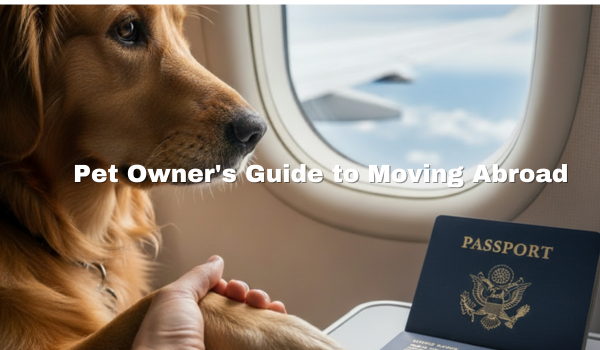Livingborderlessly
Archives
The Pet Owner's Guide to Moving Abroad | 2025 Relocation Tips
SIGN UP FOR OUR NEWSLETTER
The Pet Owner's Guide to Moving Abroad: A Stress-Free Checklist for 2025 |
Taking your furry family member overseas feels daunting, but with the right plan, it's the start of your greatest adventure together. Here’s how to navigate the process, one paw at a time 🐾. |
The decision to move abroad is monumental.
For pet owners, it carries an entirely different weight of responsibility.
You aren’t just packing your own life into boxes; you’re orchestrating the safe and comfortable passage of a beloved family member to a new continent.
It’s a journey filled with paperwork, regulations, and deadlines that can feel absolutely overwhelming.
But it is completely achievable.
Welcome to The Pet Owner's Guide to Moving Abroad, a clear roadmap designed to turn that anxiety into confident, decisive action.
The Six-Month Countdown: Your Early Game Plan
Procrastination is the single biggest threat to a smooth international pet relocation.
The process should begin at least six months before your planned departure.
Your first action is not booking a flight, but visiting your veterinarian.
This initial consultation is where you will map out the specific requirements for your destination country. |
The absolute first step in this process is verifying your pet has an
ISO 11784/11785 compliant 15-digit pet microchip.
This is non-negotiable for most countries.
If your pet has an older chip or no chip, this must be implanted immediately.
Crucially, any vaccinations administered before the microchip is implanted are considered invalid for travel purposes.
Following the microchip, your pet will need a rabies vaccination.
Many countries, especially in the European Union, require a waiting period of at least 21 days after the primary rabies shot before a pet is eligible to travel.
For stricter locations like Japan or Australia, a rabies antibody titer test may be required, which involves a blood draw and a waiting period that can last for months.
This is precisely why you must start early.
Navigating the Document Gauntlet
The paperwork is the most painstaking part of moving internationally with a pet.
The centerpiece of this effort is the international veterinary health certificate.
This document, completed by an accredited veterinarian, attests to your pet's health and vaccination status.
Here’s the catch: most countries require this certificate to be completed within a very strict timeframe, often just 10 days before your flight.
For Americans, this certificate isn’t valid until it receives an official endorsement from the U.S. Department of Agriculture (USDA) Animal and Plant Health Inspection Service (APHIS).
This final government stamp is the golden ticket that allows your pet to board the plane.
Some destinations also demand a separate import permit, which you may need to apply for months in advance.
Failing to secure an import permit where required can result in your pet being denied entry.
This is not a corner you can afford to cut.
|
Your Pet's First-Class Ticket: Booking Air Travel
Choosing how your pet will fly is a major decision impacting their comfort and safety.
For small dogs and cats, traveling in-cabin inside a carrier that fits under the seat in front of you is often the best option.
However, airline spots for in-cabin pets are extremely limited, so you must book well in advance.
For larger animals, the choice is between flying as checked baggage or as manifest cargo.
While it may sound alarming, flying in the pressurized, temperature-controlled cargo hold is very safe.
In fact, for long-haul flights, dedicated cargo services can be superior.
These services often involve specialized animal handling teams and climate-controlled waiting areas, reducing stress on your pet.
Be aware of temperature embargoes.
Many airlines will not transport animals as checked baggage during the hottest summer months or coldest winter months to protect them from extreme temperatures on the tarmac.
Whenever possible, book a direct flight to minimize transit time and the risk of mishandling during layovers.
If the logistics feel too complex, consider hiring a professional pet relocation service to manage the entire process.
|
Preparing Your Pet for the Journey
Your pet’s comfort on travel day begins weeks before you leave for the airport.
The most important thing you can do is crate train them properly.
The travel crate should be introduced as a safe, comfortable space, not a place of punishment.
Make it a cozy den with familiar blankets and favorite toys.
Feed them meals in the crate and leave the door open so they can come and go as they please.
A well-acclimated pet will experience significantly less stress during the flight.
It is critical to consult your veterinarian about sedation.
Most vets and airlines strongly advise against sedating or tranquilizing pets for air travel.
These medications can affect their breathing and ability to regulate body temperature at high altitudes, which poses a serious health risk.
On the day of travel, ensure your pet has had plenty of exercise, a light meal a few hours before leaving, and ample opportunities to relieve themselves.
Line the crate with an absorbent pad and securely attach food and water dishes to the inside of the door.
Your calm demeanor will be the most comforting thing for them.
|
FAQ: Your Top Questions Answered
What is the most important part of The Pet Owner's Guide to Moving Abroad? Timing is everything.
Starting the process 6-12 months in advance is the single best thing you can do.
This provides a buffer for any unexpected delays, such as a required second rabies shot or a lengthy wait for an import permit.
Should I hire a professional pet relocation service? If your budget allows, and especially if you are moving to a country with complex requirements like Australia or Japan, a professional service is invaluable.
They handle the logistics, book the flights, and navigate the maze of paperwork, which can significantly reduce your stress.
How much does it cost to move a pet internationally? The cost varies dramatically based on your pet's size, your destination, and the airline.
Expect to pay anywhere from $1,500 for a small cat traveling to a nearby country to well over $10,000 for a large dog traveling to a destination with quarantine.
This includes vet visits, paperwork, airfare, and the crate.
This journey is a testament to the bond you share with your pet.
With careful planning and a deep breath, you and your best friend will soon be settling into a new home, ready for your next adventure together. |

